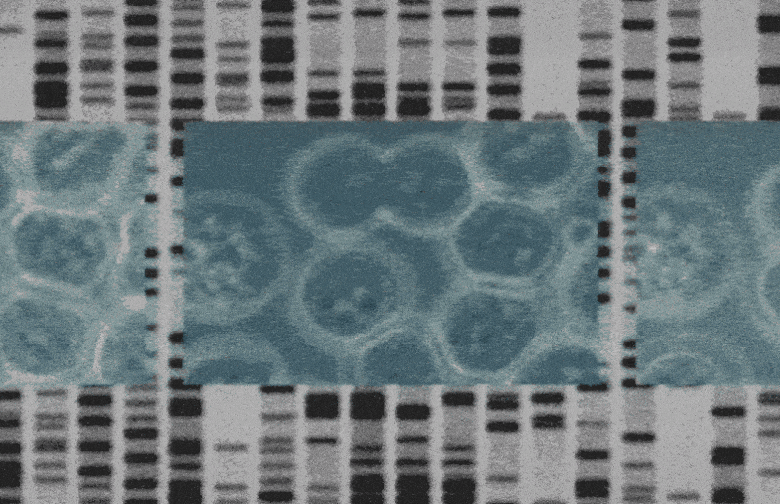[ad_1]
In the summer of 2018, 59-year-old David Gould went for his annual checkup. Expect to hear the usual things: Everything looks good– but he was informed that he had a new and unusual case of anemia.
two months later Gold began to experience many strange symptoms, his ankles extending to the width of his calves. The right side of his face was so swollen that he couldn’t open his eyes. He had a rash all over his body, joint pain, a fever and drenched in night sweats. His anemia was getting worse. And he needed frequent blood transfusions. Gould’s doctor was perplexed, he was afraid. “I started having intentions and things in order,” he told me.
Nearly two years into testing, Gould learned about an initiative at the National Institutes of Health aimed at solving some of the nation’s most perplexing medical problems. He applied to join the project, and soon his file reached the desks of Donna Novacic and David Beck, two scientists at the NIH both helping to identify as-yet-unidentified diseases. They are linked to specific genes and specific somatic mutations. This is a genetic change that is not passed down from parents and appears only in certain cells. Gould’s symptoms looked eerily similar to those of known patients with this new disease. And a blood test confirmed the scientists’ hunch: Gould had the mutation.
NIH doctors contacted Gould by phone on the day he was scheduled to begin chemotherapy. This has proven to be dangerous for other people with the same disease. They told him that a bone marrow transplant might be a riskier but more effective intervention. which he ultimately chose after careful consultation with his doctor. within a few weeks He is no longer anemic. And his once incontinent symptoms disappeared. A few months after transplantation Gold felt normal again. And since then
When the NIH team published its findings in 2020, the article created a stir in the medical community. Not only because it describes a new genetic disease. (now called VEXAS), but also because of the role of somatic mutations in the condition appears in adulthood For many doctors like me, I practice rheumatology which focuses on the treatment of autoimmune diseases. genetic disease It usually indicates a condition that is inherited by family members and present from birth. But what doctors are only now beginning to realize is that somatic mutations may help explain illnesses that were never considered “genetic” at all.
Somatic mutations occur after fertilization. This occurs after the egg meets the sperm and continues throughout life. which is stimulated by exposure to cigarette smoke ultraviolet light or other dangerous substances Our bodies are adept at catching these errors. But sometimes mistakes slip through the cracks. The result is a condition known as “Somatic mosaicism,” in which two or more groups of cells in the same body have different genetic makeup. In the past few years The discovery of conditions like VEXAS has forced scientists to question their assumptions about how somatic mosaicism is related to human disease, and in 2023 the NIH launched the Somatic Mosaic Network Across Human Tissue. (SMaHT), which means to deepen our understanding of genetic variation in cells. of the human body
During the past decade Genetic sequencing has become faster, cheaper, and much more detailed. which allows the sequencing of the genomes of various cells in same People can be more practical. and has led scientists to understand how much genetic variation exists within each of us. The DNA modifications caused by somatic mutations mean that we don’t just have one genome. It is perfectly replicated in every cell in our body, said Jake Rubens, CEO and co-founder of Quotient Therapeutics, a company that uses physical genomes to develop new treatments. It has been calculated that each of us has nearly 30 minutes. Trillion The genome is scattered throughout many of our cells. Two adjacent cells that appear to be identical under a microscope. There may be differences in the genome of approximately 1,000 cells.
One medical specialty has long understood what this shift means: oncology. Since the 1990s, doctors have known that most cancers arise from somatic mutations in genes that promote or suppress tumor growth. But discoveries like VEXAS are convincing more and more researchers that these mutations can help explain or define other types of illnesses as well. “We have data indicating that many conditions are genetic. But we don’t understand the mechanisms that cause this,” said Richard Gibbs, founding director of the Human Genome Sequencing Center at Baylor University. “Perhaps somatic mutations are events that act as the missing link,” SMaHT-funded researcher James Bennett contends. As scientists look at mutations in cells, How much of the body The more likely they are to experience specific diseases. Only get more. Until recently Genetic sequencing has been used almost exclusively for the most accessible cell types. that is blood cells But as Bennett told me These cells are sometimes rarely involved in diseases that affect various organs. He said SMaHT’s results will be “the first time we will have a map of somatic mutations throughout the body.”
For example, the brain is often considered the genetically most vulnerable organ. This is because adult brain cells do not divide very much. And genetics have rarely been tested. But in 2015, scientists in South Korea showed that people with a disease called epilepsy can have seizures because of a physical mutation that creates the wrong gene. Normal in a subset of brain cells This finding has led researchers such as Christopher Walsh, head of the genetics and genomics department at Boston Children’s Hospital, to investigate. Considered that other brain abnormalities What may occur from somatic mutations? He hypothesized that physical mutations in various parts of the brain can be described in various ways that makes autism affect different people and from a set of studies This shows that this is indeed the case for a small percentage of autistic children. Other researchers published work indicating that somatic mutations in brain cells likely contribute to schizophrenia. Parkinson’s disease and Alzheimer’s disease (Though these researchers noted that mutations are just one of many factors that contribute to these complex conditions.)
Although these mutations may help us understand the disease better, Some scientists warn that other examples A few examples would be just as neat. WITH CANCER OR VEXAS Yiming Luo, an expert in rheumatology and genetics at Columbia University Irving Medical Center (with which I am affiliated), told me that the discovery of germline mutations This is a change in DNA that a person inherits from their parents’ eggs or sperm cells. This is significantly easier than searching for somatic mutations. Germline mutations look like red balls in a sea of white balls. which is difficult to notice But it’s not impossible. Somatic mutations are greyed out. and easier to mix in “In genetics Separating sound from noise can be difficult,” Luo said, and although scientists feel confident they have found a physical mutation, But the next step is to understand the biological and clinical implications of the mutation. It may take several years.
Oncologists have a head start on translating somatic mutation science into practice. But the same can be done in other specialties. Including mine. That can be challenging, Dan Kastner, a physical therapist and one of the leading NIH scientists responsible for discovering VEXAS, told me. Although cancer involves many easily identifiable cell clones, and asked for genetic analysis Identifying a single cell that drives, for example, arthritis is much more difficult. The VEXAS story is intriguing because it found disease-causing mutations in blood cells. They are easy to sample and are the cells most often tested for genetic variation. Finding somatic mutations that cause other diseases Rheumatology and related specialties require skill, intelligence, and a willingness to test cells and organs throughout the body.
But my colleagues and I can no longer ignore the possibility that somatic mutations could affect our adult patients, VEXAS, which doctors didn’t know about five years ago. It may exist in 15,000 people across the United States. (Makes it as common as ALS, also known as Lou Gehrig’s disease.) If its prevalence around the world matched that of this country, It could affect about half a million people worldwide. And if we stop and consider the possibility that diseases we already know about are linked to somatic mutations while searching for patient diagnoses? This may help improve our practice.
Recently, I was called to evaluate a 60-year-old man whose medical history was littered with unexplained signs and symptoms, including swollen lymph nodes, joint pain, and abnormal blood cell counts.–That left his team of experts stumped. To my surprise, his skin was covered in xanthomas. which is fatty tissue that is yellow in color, resembling wax Even though his cholesterol levels were normal. And I learned through Google that one of the possible causes is Erdheim-Chester disease. which are rare blood cells Abnormalities that occur due to somatic mutations
I wonder if I’m losing my sight. Considering his newfound obsession, However, because the patient had already had a lymph node and bone marrow biopsy. We then sent those biopsies for molecular testing. Both samples came back with the same discovery: somatic mutations related to Erdheim-Chester Once I emailed a local expert about the disease. I still expect a gentle warning for being too eager to invoke this extremely unusual diagnosis. But within minutes he said yes, this patient might have. Erdheim-Chester And he was willing to see the man at his clinic immediately.
I sat at the computer staring at this answer. I couldn’t even contemplate a possible diagnosis for this patient a year ago, but here it is: an adult-onset condition. It masquerades as an autoimmune illness but is actually caused by a physical mutation. The diagnosis felt too perfect to be true. And in some ways it is. Fewer than 1,500 people have ever experienced this condition. But at the same time It makes me wonder. If rethinking genetic disease helps this person, how many other people are waiting for similar answers?
[ad_2]
Source link



